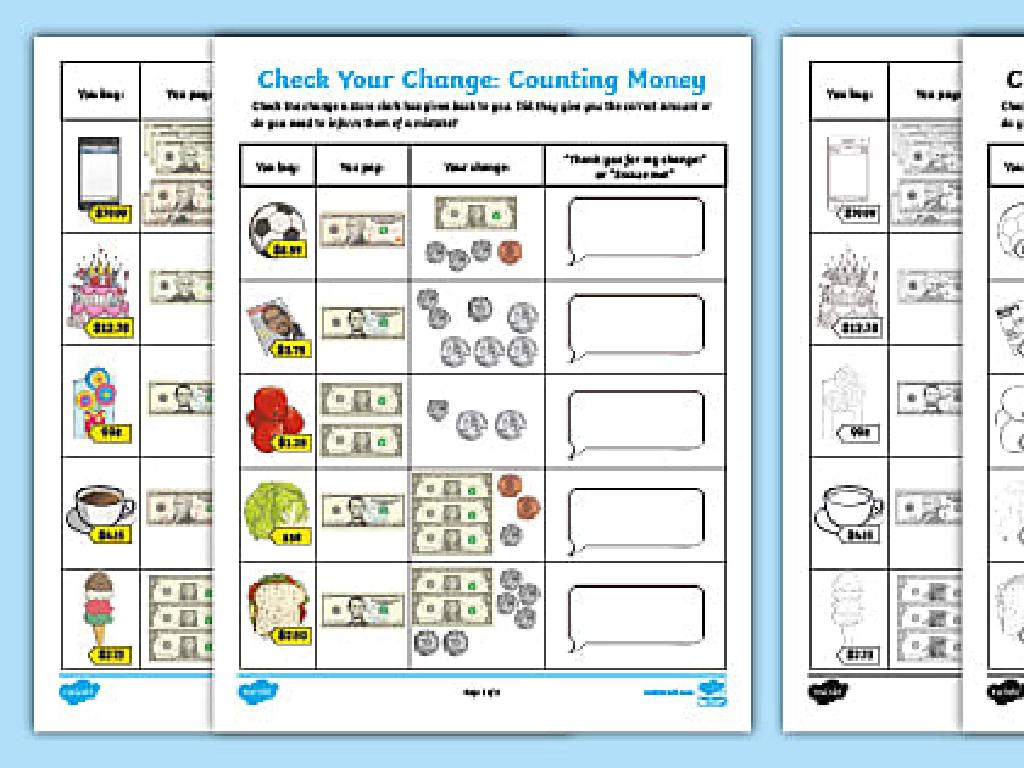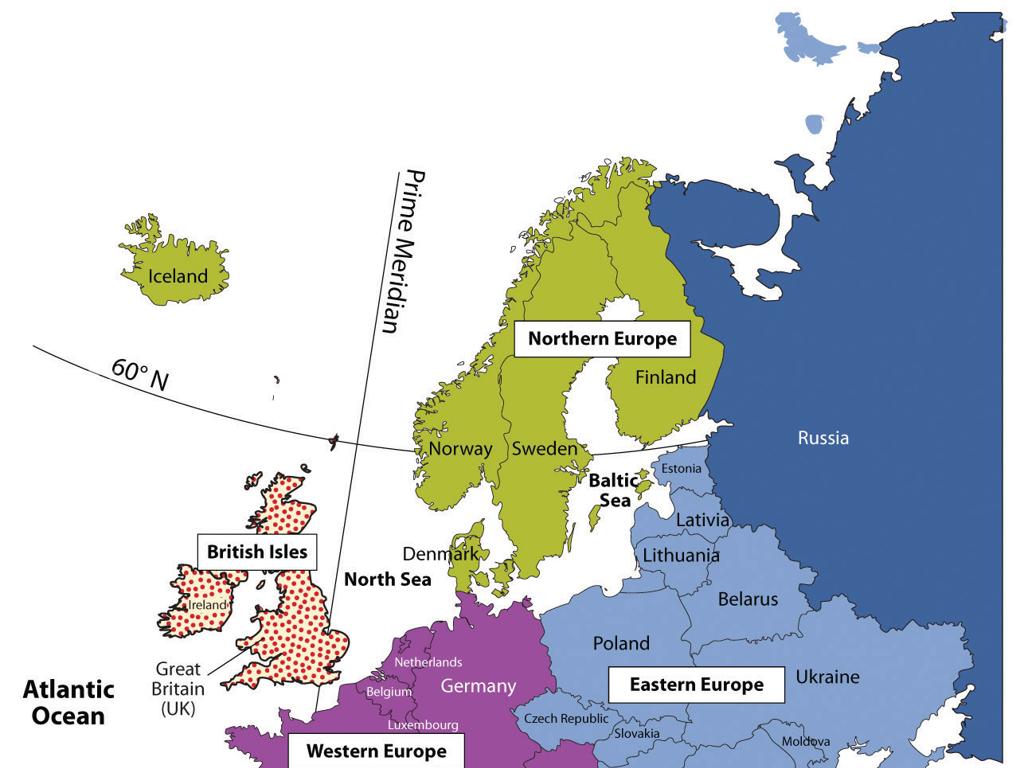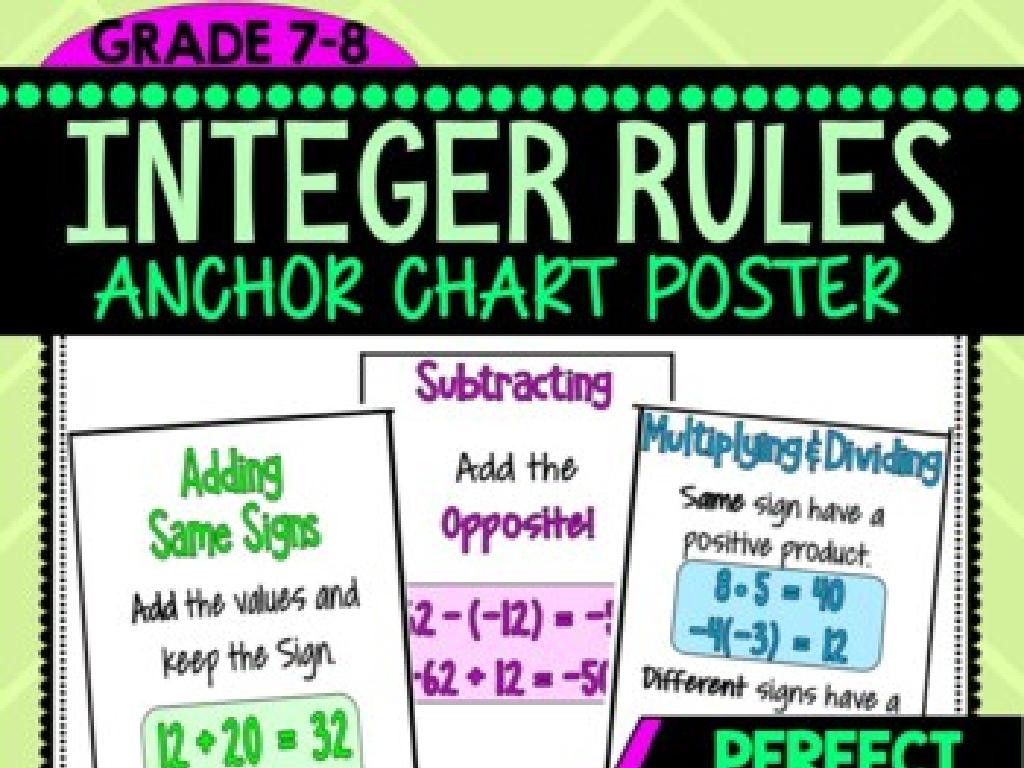Graph Points On A Coordinate Plane
Subject: Math
Grade: Fifth grade
Topic: Coordinate Plane
Please LOG IN to download the presentation. Access is available to registered users only.
View More Content
Welcome to Coordinate Planes!
– Basics of a coordinate plane
– A grid with two number lines: the x-axis and y-axis
– Coordinate planes in daily life
– Used in maps, video games, and more
– Today’s goal: graphing points
– Learn to place points using (x, y) coordinates
– Practice plotting points
|
Begin with an introduction to the coordinate plane, explaining its parts: the horizontal x-axis and vertical y-axis, and how they intersect at the origin. Discuss how coordinate planes are not just a math concept but are also used in real life, such as in navigation with maps or in creating computer graphics. Today’s goal is to ensure students understand how to graph points on a coordinate plane by using ordered pairs (x, y). Provide examples and then let students practice plotting points to reinforce the lesson. Encourage them to ask questions and assist each other to foster collaborative learning.
Exploring the Coordinate Plane
– Define a coordinate plane
– A flat surface with two number lines: the x-axis and y-axis
– Identify parts of the plane
– x-axis (horizontal), y-axis (vertical), origin (where they intersect)
– Understand the four quadrants
– Quadrants are four sections made by the axes, labeled I, II, III, IV
– Locate points on the plane
– Use ordered pairs (x, y) to find points where lines from each axis meet
|
Begin with a simple definition of a coordinate plane, ensuring students understand it as a foundational concept in graphing. Introduce the parts of the coordinate plane: the horizontal x-axis, the vertical y-axis, and the origin where they intersect. Explain the concept of quadrants, the four distinct areas created by the axes, and how they are labeled using Roman numerals. Emphasize the importance of the origin as the starting point for locating other points. Conclude by showing how to graph points using ordered pairs, which represent positions along the x-axis and y-axis. Provide examples and encourage students to practice plotting points in different quadrants.
Plotting Points on the Coordinate Plane
– Understanding coordinates (x, y)
– Coordinates are like an address for a point, where ‘x’ is horizontal and ‘y’ is vertical.
– Steps to plot points on the plane
– Find ‘x’ on the horizontal axis, then ‘y’ on the vertical, and mark where they meet.
– Example: Plot point (3, 2)
– Start at the origin (0,0), move 3 steps right (x), and 2 steps up (y), then draw the point.
|
This slide introduces students to the concept of plotting points on a coordinate plane. Begin by explaining that coordinates are like an address for a point, with ‘x’ indicating the horizontal position and ‘y’ the vertical. Demonstrate the steps to plot a point: locate the ‘x’ value on the horizontal axis, then find the ‘y’ value on the vertical axis, and mark the point where these two meet. Use the example (3, 2) to show this process visually. Have students practice with additional points and ensure they understand the order of coordinates and the importance of starting from the origin. Encourage them to think of the coordinate plane as a map that helps them find the exact location of points.
Let’s Practice Together: Plotting Points
– Class Activity: Plot (4, -1) on a graph
– Share your graph with a classmate
– Discuss the similarity of plotted points
– Understand why points should match
– If everyone plotted correctly, all points should be the same because coordinates are precise locations.
|
This slide introduces a hands-on activity where students will apply their knowledge of coordinate planes by plotting a specific point. Provide each student with graph paper and instruct them to plot the point (4, -1). After plotting, students should pair up to compare their graphs. Facilitate a class discussion on why everyone’s plotted point should look the same, emphasizing the precision and consistency of the coordinate plane. This activity will help solidify their understanding of graphing points and the importance of accuracy. Possible variations of the activity could include plotting multiple points, connecting points to form shapes, or even creating a game where students guess the coordinates based on plotted points.
Coordinate Planes in Real Life
– Navigation with coordinates
– GPS systems use coordinates to set destinations.
– Video games use coordinates
– Characters move on a grid, similar to a coordinate plane.
– Art and design
– Artists use grids to maintain proportion.
– Understanding maps
– Maps are a grid system, like a big coordinate plane.
|
This slide aims to show students the practical applications of coordinate planes beyond the classroom. By understanding how coordinate planes are used in everyday life, such as in GPS navigation, video game programming, and creating art, students can better grasp the concept and its importance. Discuss how GPS systems rely on latitude and longitude, similar to x and y coordinates. Relate the movement of characters in video games to navigating through the quadrants of a coordinate plane. Explain how artists use grids to scale drawings accurately. Finally, make the connection between reading maps and understanding coordinate planes, as both involve interpreting points on a grid. Encourage students to think of other examples where they might encounter coordinate planes in their daily lives.
Class Activity: Coordinate Plane Treasure Hunt
– Understand coordinate clues
– Work together in small groups
– Solve clues to find the treasure
– Each clue leads to a point on the coordinate plane
– Compete for a fun prize!
|
This interactive class activity is designed to help students apply their knowledge of the coordinate plane in a fun and engaging way. Divide the class into small groups and provide each with a set of coordinate clues that they must interpret to find specific points on a grid. These points will lead them to the ‘treasure’ a location in the classroom. The first group to correctly plot all points and find the treasure will receive a small prize. This activity encourages teamwork, critical thinking, and practical application of graphing points on a coordinate plane. Possible variations of the activity could include riddles that lead to the coordinates, a larger-scale hunt around the school, or incorporating math problems that need to be solved to receive the next clue.
Wrapping Up: Coordinates & Homework
– Recap today’s coordinate lesson
– Homework: Coordinate worksheet
– Finish the worksheet on plotting points
– Next: Shapes on the plane
– We’ll learn to identify shapes by their coordinates
– Keep practicing coordinates!
– Practice makes perfect with graphing!
|
As we conclude today’s lesson on graphing points on a coordinate plane, provide a brief review of the key concepts covered. For homework, assign the provided worksheet which will reinforce students’ skills in plotting points. In the next class, we will build on this foundation by exploring how different shapes can be represented and identified on the coordinate plane. Encourage students to practice plotting points at home to become more comfortable with the process. Remember to check for understanding and answer any questions before they leave.





